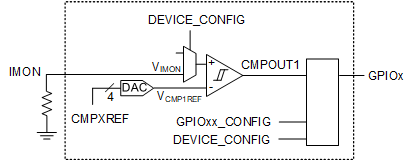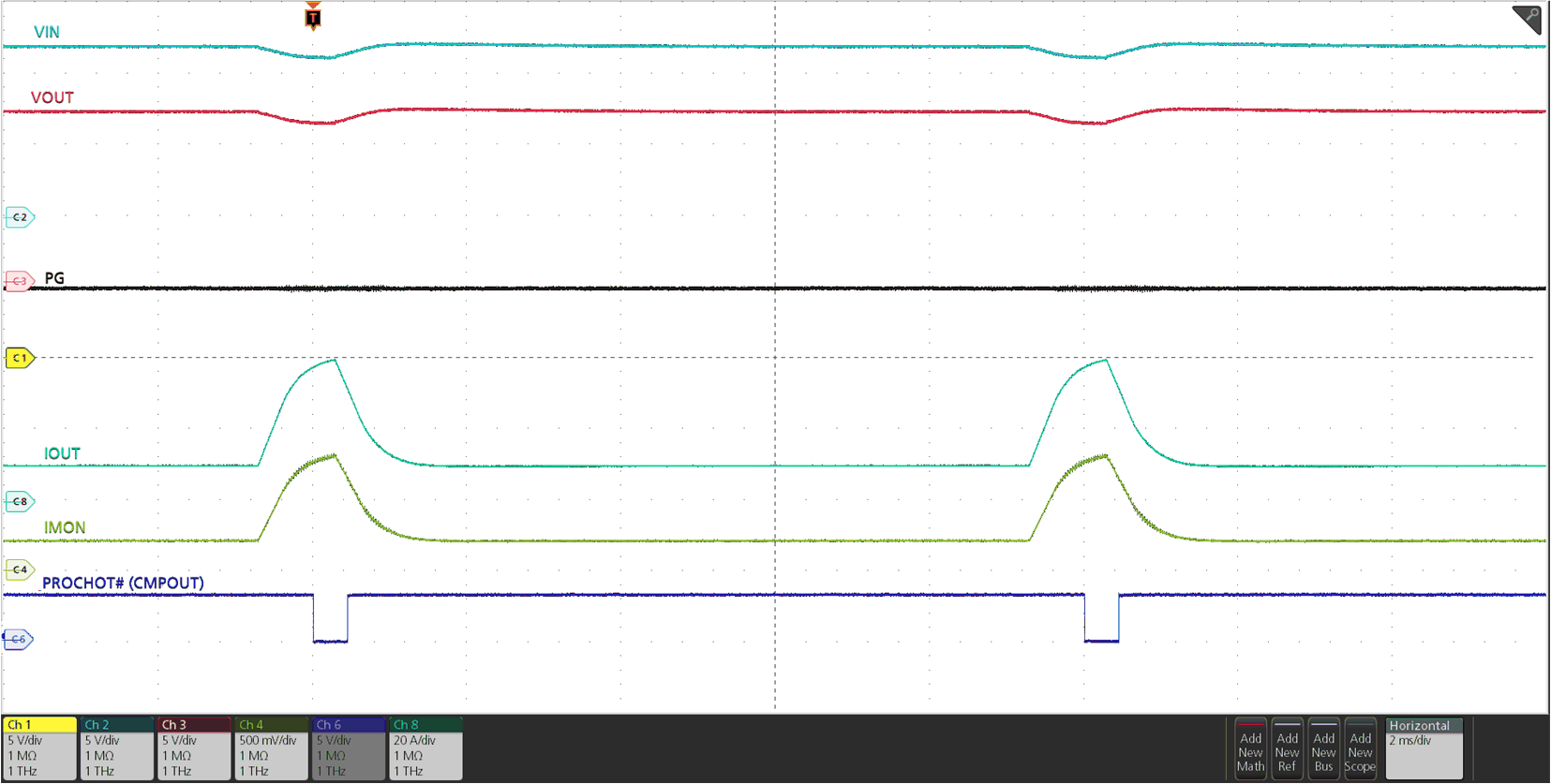JAJSMF5B september 2022 – june 2023 TPS25990
PRODUCTION DATA
- 1
- 1 特長
- 2 アプリケーション
- 3 概要
- 4 Revision History
- 5 概要 (続き)
- 6 Pin Configuration and Functions
-
7 Specifications
- 7.1 Absolute Maximum Ratings
- 7.2 ESD Ratings
- 7.3 Recommended Operating Conditions
- 7.4 Thermal Information
- 7.5 Electrical Characteristics
- 7.6 Logic Interface DC Characteristics
- 7.7 Telemetry
- 7.8 PMBus Interface Timing Characteristics
- 7.9 External EEPROM Interface Timing Characteristics
- 7.10 Timing Requirements
- 7.11 Switching Characteristics
- 7.12 Typical Characteristics
-
8 Detailed Description
- 8.1 Overview
- 8.2 Functional Block Diagram
- 8.3
Feature Description
- 8.3.1 Undervoltage Protection
- 8.3.2 Insertion Delay
- 8.3.3 Overvoltage Protection
- 8.3.4 Inrush Current, Overcurrent, and Short-Circuit Protection
- 8.3.5 Single Point Failure Mitigation
- 8.3.6 Analog Load Current Monitor (IMON)
- 8.3.7 Overtemperature Protection
- 8.3.8 Analog Junction Temperature Monitor (TEMP)
- 8.3.9 FET Health Monitoring
- 8.3.10 General Purpose Digital Input/Output Pins
- 8.3.11 Stacking Multiple eFuses for Unlimited Scalability
- 8.3.12 General Purpose Comparators
- 8.3.13 Output Discharge
- 8.3.14
PMBus® Digital Interface
- 8.3.14.1 PMBus® Device Addressing
- 8.3.14.2 SMBus Protocol
- 8.3.14.3 SMBus™ Message Formats
- 8.3.14.4 Packet Error Checking
- 8.3.14.5 Group Commands
- 8.3.14.6 SMBus™ Alert Response Address (ARA)
- 8.3.14.7
PMBus® Commands
- 8.3.14.7.1
Detailed Descriptions of PMBus® Commands
- 8.3.14.7.1.1 OPERATION (01h, Read/Write Byte)
- 8.3.14.7.1.2 CLEAR_FAULTS (03h, Send Byte)
- 8.3.14.7.1.3 RESTORE_FACTORY_DEFAULTS (12h, Send Byte)
- 8.3.14.7.1.4 STORE_USER_ALL (15h, Send Byte)
- 8.3.14.7.1.5 RESTORE_USER_ALL (16h, Send Byte)
- 8.3.14.7.1.6 BB_ERASE (F5h, Send Byte)
- 8.3.14.7.1.7 FETCH_BB_EEPROM (F6h, Send Byte)
- 8.3.14.7.1.8 POWER_CYCLE (D9h, Send Byte)
- 8.3.14.7.1.9 MFR_WRITE_PROTECT (F8h, Read/Write Byte)
- 8.3.14.7.1.10 CAPABILITY (19h, Read Byte)
- 8.3.14.7.1.11 STATUS_BYTE (78h, Read Byte)
- 8.3.14.7.1.12 STATUS_WORD (79h, Read Word)
- 8.3.14.7.1.13 STATUS_OUT (7Ah, Read Byte)
- 8.3.14.7.1.14 STATUS_IOUT (7Bh, Read Byte)
- 8.3.14.7.1.15 STATUS_INPUT (7Ch, Read Byte)
- 8.3.14.7.1.16 STATUS_TEMP (7Dh, Read Byte)
- 8.3.14.7.1.17 STATUS_CML (7Eh, Read Byte)
- 8.3.14.7.1.18 STATUS_MFR_SPECIFIC (80h, Read Byte)
- 8.3.14.7.1.19 STATUS_MFR_SPECIFIC_2 (F3h, Read Word)
- 8.3.14.7.1.20 PMBUS_REVISION (98h, Read Byte)
- 8.3.14.7.1.21 MFR_ID (99h, Block Read)
- 8.3.14.7.1.22 MFR_MODEL (9Ah, Block Read)
- 8.3.14.7.1.23 MFR_REVISION (9Bh, Block Read)
- 8.3.14.7.1.24 READ_VIN (88h, Read Word)
- 8.3.14.7.1.25 READ_VOUT (8Bh, Read Word)
- 8.3.14.7.1.26 READ_IIN (89h, Read Word)
- 8.3.14.7.1.27 READ_TEMPERATURE_1 (8Dh, Read Word)
- 8.3.14.7.1.28 READ_VAUX (D0h, Read Word)
- 8.3.14.7.1.29 READ_PIN (97h, Read Word)
- 8.3.14.7.1.30 READ_EIN (86h, Block Read)
- 8.3.14.7.1.31 READ_VIN_AVG (DCh, Read Word)
- 8.3.14.7.1.32 READ_VIN_MIN (D1h, Read Word)
- 8.3.14.7.1.33 READ_VIN_PEAK (D2h, Read Word)
- 8.3.14.7.1.34 READ_VOUT_AVG (DDh, Read Word)
- 8.3.14.7.1.35 READ_VOUT_MIN (DAh, Read Word)
- 8.3.14.7.1.36 READ_IIN_AVG (DEh, Read Word)
- 8.3.14.7.1.37 READ_IIN_PEAK (D4h, Read Word)
- 8.3.14.7.1.38 READ_TEMP_AVG (D6h, Read Word)
- 8.3.14.7.1.39 READ_TEMP_PEAK (D7h, Read Word)
- 8.3.14.7.1.40 READ_PIN_AVG (DFh, Read Word)
- 8.3.14.7.1.41 READ_PIN_PEAK (D5h, Read Word)
- 8.3.14.7.1.42 READ_SAMPLE_BUF (D8h, Block Read)
- 8.3.14.7.1.43 READ_BB_RAM (FDh, Block Read)
- 8.3.14.7.1.44 READ_BB_EEPROM (F4h, Block Read)
- 8.3.14.7.1.45 BB_TIMER (FAh, Read Byte)
- 8.3.14.7.1.46 PMBUS_ADDR (FBh, Read/Write Byte)
- 8.3.14.7.1.47 VIN_UV_WARN (58h, Read/Write Word)
- 8.3.14.7.1.48 VIN_UV_FLT (59h, Read/Write Word)
- 8.3.14.7.1.49 VIN_OV_WARN (57h, Read/Write Word)
- 8.3.14.7.1.50 VIN_OV_FLT (55h, Read/Write Word)
- 8.3.14.7.1.51 VOUT_UV_WARN (43h, Read/Write Word)
- 8.3.14.7.1.52 VOUT_PGTH (5Fh, Read/Write Word)
- 8.3.14.7.1.53 OT_WARN (51h, Read/Write Word)
- 8.3.14.7.1.54 OT_FLT (4Fh, Read/Write Word)
- 8.3.14.7.1.55 PIN_OP_WARN (6Bh, Read/Write Word)
- 8.3.14.7.1.56 IIN_OC_WARN (5Dh, Read/Write Word)
- 8.3.14.7.1.57 VIREF (E0h, Read/Write Byte)
- 8.3.14.7.1.58 GPIO_CONFIG_12 (E1h, Read/Write Byte)
- 8.3.14.7.1.59 GPIO_CONFIG_34 (E2h, Read/Write Byte)
- 8.3.14.7.1.60 ALERT_MASK (DBh, Read/Write Word)
- 8.3.14.7.1.61 FAULT_MASK (E3h, Read/Write Word)
- 8.3.14.7.1.62 DEVICE_CONFIG (E4h, Read/Write Word)
- 8.3.14.7.1.63 BB_CONFIG (E5h, Read/Write Byte)
- 8.3.14.7.1.64 OC_TIMER (E6h, Read/Write Byte)
- 8.3.14.7.1.65 RETRY_CONFIG (E7h, Read/Write Byte)
- 8.3.14.7.1.66 ADC_CONFIG_1 (E8h, Read/Write Byte)
- 8.3.14.7.1.67 ADC_CONFIG_2 (E9h, Read/Write Byte)
- 8.3.14.7.1.68 PK_MIN_AVG (EAh, Read/Write Byte)
- 8.3.14.7.1.69 VCMPxREF (EBh, Read/Write Byte)
- 8.3.14.7.1.70 PSU_VOLTAGE (ECh, Read/Write Byte)
- 8.3.14.7.1.71 CABLE_DROP (EDh, Read/Write Byte)
- 8.3.14.7.1.72 GPDAC1 (F0h, Read/Write Byte)
- 8.3.14.7.1.73 GPDAC2 (F1h, Read/Write Byte)
- 8.3.14.7.1.74 INS_DLY (F9h, Read/Write Byte)
- 8.3.14.7.1
Detailed Descriptions of PMBus® Commands
- 8.3.14.8 Analog-to-digital Converter
- 8.3.14.9 Digital-to-analog Converters
- 8.3.14.10 DIRECT format Conversion
- 8.3.14.11 Blackbox Fault Recording
- 8.4 Device Functional Modes
- 9 Application and Implementation
- 10Device and Documentation Support
- 11Mechanical, Packaging, and Orderable Information
8.3.12 General Purpose Comparators
The device has two (2) general purpose comparators (CMP1 and CMP2) whose inputs, thresholds and outputs can be digitally configured. This allows the user complete flexibility to use these comparators as per system needs.
Comparator-1:
The positive input of the comparator can be connected to either the TEMP/CMP pin, or internally to the IMON pin. Refer to the DEVICE_CONFIG register for more details and configuration options.
The comparator threshold can be digitally configured using an internal DAC (CMP1REF). Refer to the VCMPxREF register for more details and configuration options.
The comparator output can be digitally configured to be an output on one of the GPIO pins or used to trigger a fault which controls the FET ON/OFF status internally. Also, the comparator output polarity can be digitally configured. Refer to the GPIO_CONFIG_12, GPIO_CONFIG_34, and DEVICE_CONFIG registers for more details and configuration options.
Comparator-2:
The comparator's positive input is internally connected to the AUX pin.
The comparator threshold can be digitally configured using an internal DAC (CMP2REF). Refer to the VCMPxREF register for more details and configuration options.
The comparator output can be digitally configured to be an output on one of the GPIO pins or used to trigger a fault which controls the FET ON/OFF status internally. Also, the comparator output polarity can be digitally configured. Refer to the GPIO_CONFIG_12, GPIO_CONFIG_34, and DEVICE_CONFIG registers for more details and configuration options.
These comparators can be used for various purposes. Here is one such example:
Programmable fast overcurrent detect (PROCHOT#): Comparator-1 is configured to take IMON pin as the input and an appropriate reference voltage is set using the internal DAC (CMP1REF) in the VCMPxREF register. The comparator output is configured to be brought out on one of the General Purpose I/O pins. This pin is connected to the PROCHOT# pin of the processor. When the load current crosses the set threshold, the GPIOx goes low and signals the processor to throttle down immediately.
 Figure 8-8 Programmable Fast Overcurrent (PROCHOT#) Detect Using Internal Comparator and General Purpose I/O
Figure 8-8 Programmable Fast Overcurrent (PROCHOT#) Detect Using Internal Comparator and General Purpose I/O Figure 8-9 PROCHOT# Response Using Internal Comparator
Figure 8-9 PROCHOT# Response Using Internal Comparator